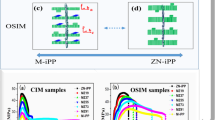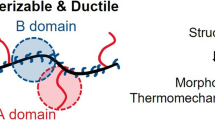Abstract
The manufacturing of plastics traditionally involves melt processing at temperatures typically greater than 200 °C—to enable extrusion or moulding under pressure into desired forms—followed by solidification. This process consumes energy and can cause substantial degradation of polymers and additives (such as flame retardants and ultraviolet stabilizers), limiting plastics performance and recyclability1. It was recently reported that the application of pressure could induce melt-like behaviour in the block copolymer polystyrene-block-poly(n-butyl methacrylate) (PS-b-PBMA)2, and this behaviour has now been demonstrated in a range of other block copolymer systems3,4,5,6,7,8. These polymers have been termed baroplastics2,3,4,5. However, in each case, the order-to-disorder transition, which gives rise to the accompanying change in rheology from soft solid to melt9,10, was observed at temperatures far exceeding the glass transition temperatures (Tg) of both components. Here we show that baroplastic systems containing nanophase domains of one high-Tg and one low-Tg component can exhibit melt-like flow under pressure at ambient temperature through an apparent semi-solid partial mixing mechanism that substantially preserves the high-Tg phase. These systems were shredded and remoulded ten times with no evident property degradation. Baroplastics with low-temperature formability promise lower energy consumption in manufacture and processing, reduced use of additives, faster production and improved recyclability, and also provide potential alternatives to current thermoplastic elastomers, rubber-modified plastics, and semi-crystalline polymers11,12.
This is a preview of subscription content, access via your institution
Access options
Subscribe to this journal
Receive 51 print issues and online access
$199.00 per year
only $3.90 per issue
Buy this article
- Purchase on Springer Link
- Instant access to full article PDF
Prices may be subject to local taxes which are calculated during checkout



Similar content being viewed by others
References
Herbst, H., et al. in Frontiers in the Science and Technology of Recycling (ed. Akovali, G.) 73–101 (Kluwer Academic, Dordrecht, The Netherlands, 1997)
Pollard, M., Russell, T. P., Ruzette, A. V., Mayes, A. M. & Gallot, Y. The effect of hydrostatic pressure on the lower critical ordering transition in diblock copolymers. Macromolecules 31, 6493–6498 (1998)
Ruzette, A.-V. G., Mayes, A. M., Pollard, M., Russell, T. P. & Hammouda, B. Pressure effects on the phase behavior of styrene/n-alkyl methacrylate block copolymers. Macromolecules 36, 3351–3356 (2003)
Ruzette, A.-V. G., Banerjee, P., Mayes, A. M. & Russell, T. P. A simple model for baroplastic behavior in block copolymer melts. J. Chem. Phys. 114, 8205–8209 (2001)
Ryu, D. Y., Lee, D. J., Kim, J. K., Lavery, K. A. & Russell, T. P. Effect of hydrostatic pressure on closed-loop phase behavior of block copolymers. Phys. Rev. Lett. 90, 235501 (2003)
Hasegawa, H. et al. Small-angle neutron scattering studies on phase behavior of block copolymers. J. Phys. Chem. Solids 60, 1307–1312 (1999)
Frielinghaus, H., Schwahn, D., Mortensen, K., Almdal, K. & Springer, T. Composition fluctuations and coil conformations in a poly(ethylene-propylene)-poly(ethyl ethylene) diblock copolymer as a function of temperature and pressure. Macromolecules 29, 3263–3271 (1996)
Schwahn, D., Frielinghaus, H., Mortensen, K. & Almdal, K. Temperature and pressure dependence of the order parameter fluctuations, conformational compressibility, and the phase diagram of the PEP-PDMS diblock copolymer. Phys. Rev. Lett. 77, 3153–3156 (1996)
Russell, T. P., Karis, T. E., Gallot, Y. & Mayes, A. M. Lower critical ordering transition in a diblock copolymer melt. Nature 368, 729–731 (1994)
Ryu, D. Y., Jeong, U., Kim, J. K. & Russell, T. P. Closed-loop phase behaviour in block copolymers. Nature Mater. 1, 114–117 (2002)
Holden, G. et al. in Thermoplastic Elastomers (ed. Holden, G.) 573–599 (Hanser, Munich/Vienna/New York, 1996)
Ehrenstein, G. H. Polymeric Materials 63–89, 98–116 (Hanser, Munich, 2001)
Ruzette, A.-V. G. & Mayes, A. M. A simple free energy model for weakly interacting polymer blends. Macromolecules 34, 1894–1907 (2001)
Gonzalez-Leon, J. A. & Mayes, A. M. Phase behavior prediction of ternary polymer mixtures. Macromolecules 36, 2508–2515 (2003)
Ruzette, A.-V. G. et al. Phase behavior of diblock copolymers between styrene and n alkyl methacrylates. Macromolecules 31, 8509–8517 (1998)
Hajduk, D. A., Urayama, P., Gruner, S. M. & Erramilli, S. High-pressure effects on the disordered phase of block copolymer melts. Macromolecules 28, 7148–7156 (1995)
Hajduk, D. A., Gruner, S. M., Erramilli, S., Register, R. A. & Fetters, L. J. High-pressure effects on the order/disorder transition in block copolymer melts. Macromolecules 29, 1473–1481 (1996)
Steinhoff, B. et al. Pressure dependence of the order-to-disorder transition in polystyrene/polyisoprene and polystyrene/ poly(methylphenylsiloxane) diblock copolymers. Macromolecules 31, 36–40 (1998)
Migler, K. B. & Han, C. C. Static and kinetic study of a pressure-induced order-disorder transition: birefringence and neutron scattering. Macromolecules 31, 300–305 (1998)
Patten, T. E. & Matyjaszewski, K. Atom transfer radical polymerization and the synthesis of polymeric materials. Adv. Mater. 10, 901–915 (1998)
Malmstrom, E. E. & Hawker, C. J. Macromolecular engineering via ‘living’ free radical polymerizations. Macromol. Chem. Phys. 199, 923–935 (1998)
Hillmyer, M. Block copolymer synthesis. Curr. Opin. Solid State Mater. Sci. 4, 559–564 (1999)
Ha, J. W., Park, I. J., Lee, S. B. & Kim, D. K. Preparation and characterization of core–shell particles containing perfluoroalkyl acrylate in the shell. Macromolecules 35, 6811–6818 (2002)
Keddie, J. L. Film formation of latex. Mater. Sci. Eng. R 21, 101–170 (1997)
Dos Santos, F. D. & Leibler, L. Large deformation films from soft-core/hard-shell hydrophobic latexes. J. Polym. Sci. B 41, 224–234 (2003)
Lovell, P. A. & Pierre, D. in Emulsion Polymerization and Emulsion Polymers (eds Lovell, P. A. & Aasser, M. S.) 657–695 (John Wiley & Sons, New York, 1997)
Flemings, M. C. Behavior of metal alloys in the semisolid state. Metall. Trans. B 22, 269–293 (1991)
Shipp, D. A., Wang, J.-L. & Matyjaszewski, K. Synthesis of acrylate and methacrylate block copolymers using atom transfer radical polymerization. Macromolecules 31, 8005–8008 (1998)
Cassebras, M., Pascual, S., Polton, A., Tardi, M. & Vairon, J. P. Synthesis of di- and triblock copolymers of styrene and butyl acrylate by controlled atom transfer radical polymerization. Macromol. Rapid Commun. 20, 261–264 (1999)
Acknowledgements
We acknowledge the support of the Seaver Institute, the Lord Foundation, Lord Corporation, the MRSEC Program of the National Science Foundation and the Office of Naval Research. This work benefited from the use of the Los Alamos Neutron Science Center at the Los Alamos National Laboratory, funded by the US Department of Energy.
Author information
Authors and Affiliations
Corresponding author
Ethics declarations
Competing interests
The authors declare that they have no competing financial interests.
Rights and permissions
About this article
Cite this article
Gonzalez-Leon, J., Acar, M., Ryu, SW. et al. Low-temperature processing of ‘baroplastics’ by pressure-induced flow. Nature 426, 424–428 (2003). https://doi.org/10.1038/nature02140
Received:
Accepted:
Issue Date:
DOI: https://doi.org/10.1038/nature02140
This article is cited by
-
The Effects of Loading of Montmorillonite (MMT) on the Properties of the Ultra-High Molecular Weight Polyethylene (UHMWPE/Organo-MMT) Nanocomposite Sheets Prepared by Gel and Pressure Induced Flow (PIF) Processing
Arabian Journal for Science and Engineering (2013)
-
Hartree analysis of χ for a pressure-responsive diblock copolymer: Temperature-pressure superposition
Macromolecular Research (2012)
-
Room temperature baroplastic processing of PS/PBA nano-blends
Macromolecular Research (2012)
-
Morphological similarity of a tri-block copolymer processed at ambient and elevated temperatures
Korea-Australia Rheology Journal (2012)
-
Driving force for phase segregation in polymer mixtures
Macromolecular Research (2011)
Comments
By submitting a comment you agree to abide by our Terms and Community Guidelines. If you find something abusive or that does not comply with our terms or guidelines please flag it as inappropriate.



